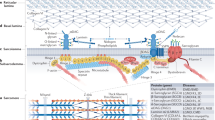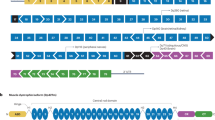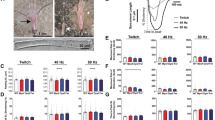Abstract
Duchenne muscular dystrophy (DMD) and its milder form, Becker muscular dystrophy (BMD), are allelic X-linked muscle disorders in man1. The gene responsible for the disease has been cloned from knowledge of its map location at band Xp21 on the short arm of the X chromosome2–5. The product of the DMD gene, a protein of relative molecular mass 400,000 (Mr 400K) recently named dystrophin, has been reported to co-purify with triads of mouse and rabbit skeletal muscle when assayed using polyclonal antibodies raised against fusion proteins encoded by regions of mouse DMD complementary DNA6,7. Here we show that anti-bodies directed against synthetic peptides and fusion proteins derived from the N-terminal region of human DMD cDNA strongly react with an antigen present in skeletal muscle sar-colemma on cryostat sections of normal human muscle biopsies. This immunoreactivity is reduced or absent in muscle fibres from DMD patients but appears normal in muscle fibres from patients with other myopathic diseases. The same antibodies specifically react with a 400K protein in sodium dodecyl sulphate (SDS) extracts of normal human muscle subjected to Western blot analysis. We conclude that the product of the DMD gene is associated with the sarcolemma rather than with the triads and speculate that it strengthens the sarcolemma by anchoring elements of the internal cytoskeleton to the surface membrane.
This is a preview of subscription content, access via your institution
Access options
Subscribe to this journal
Receive 51 print issues and online access
$199.00 per year
only $3.90 per issue
Buy this article
- Purchase on Springer Link
- Instant access to full article PDF
Prices may be subject to local taxes which are calculated during checkout
Similar content being viewed by others
References
Worton, R. G. & Burghes, A. H. M. Int. Rev. Neurol. 29, 1–75 (1988).
Monaco, A. P. et al. Nature 323, 646–650 (1986).
Koenig, M. et al. Cell 50, 503–517 (1987).
Hoffman, E. P., Monaco, A. P., Feener, C. C. & Kunkel, L. M. Science 238, 347–350 (1987).
Burghes, A. H. M. et al. Nature 328, 434–437 (1987).
Hoffman, E. P., Brown, R. H. & Kunkel, L. M. Cell 51, 919–928 (1987).
Hoffman, E. P., Knudson, C. M., Campbell, K. P. & Kunkel, L. M. Nature 330, 754–758 (1987).
Parker, J. M. R. & Hodges, R. S. J. Protein Chem. 3, 465–478 (1985).
Hammonds, R. G. Cell 51 (1987).
Lipman, D. J. & Pearson, W. R. Science 227, 1435–1441.
Nilsson, B., Abrahamsen, L. & Uhlén, M. EMBO J. 4, 1075–1080 (1985).
Spindler, K. R., Rossen, D. S. E. & Berk, A. J. J. Virol. 49, 132–141 (1984).
Engvall, E. & Perlmann, P. P. Immunochemistry 8, 871–879 (1971).
Affinity Chromatography: Principles and Methods 8–15 (Pharmacia Fine Chemicals, Sweden, 1977).
Wang, K., McClure, J. & Tu, A. Proc. natn Acad. Sci. U.S.A. 76, 3698–3702 (1979).
Sugita, H. et al. Proc. Japan Acad. 63, 107–110 (1987).
Karpati, G. et al. Ann. Neurol. 20, 38–49 (1986).
Lev, M. A., Feener, C. C., Kunkel, L. M. & Brown, R. H. J. Biol. Chem. 262, 15817–15820 (1987).
Hyser, C., Province, M. & Griggs, R. C. Ann. Neurol. 22, 553–555 (1987).
Davison, M. D. & Critchley, D. R. Cell 52, 159–160 (1988).
Ebashi, S., Ebashi, F. & Manuyama, K. Nature 203, 645–646 (1964).
Lazarides, E. & Nelson, W. J. Cell 31, 505–508 (1982).
Appleyard, S. T. et al. Proc. natn. Acad. Sci. U.S.A. 81, 776–780 (1984).
Sugita, H. et al. Proc. Japan. Acad. 64, 37–39 (1–988).
Mokri, B. & Engel, A. G. Neurology 25, 1111–1120 (1975).
Carpenter, S. & Karpati, G. Brain 102, 147–161 (1979).
Ruoslahti, E. & Pierschbacher, M. D. Science 238, 491–497 (1987).
Karpati, G. & Carpenter, S. Am. J. med. Genet. 25, 653–658 (1986).
Ray, P. N. et al. Nature 318, 671–675 (1985).
Kunkel, L. M. et al. Proc. natn. Acad. Sci. U.S.A. 82, 4778–4782 (1985).
Piszkiewicz, D., Landon, M. & Smith, E. L. Biochem. biophys. Res. Commun. 40, 1173–1178 (1970).
Laemmli, U.K. Nature 227, 680–685 (1970).
Towbin, H., Stachelin, T. & Gordon, J. Proc. natn. Acad. Sci. U.S.A. 76, 4350–4354 (1979).
Nielsen, D. A. & Shapiro, D. J. Nucleic Acids Res. 14, 5936 (1986).
Zubrzycka-Gaarn, E. E. et al. J. biol. Chem. 258, 4576–4581 (1983).
Lowry, D. H. et al. J. biol. Chem. 193, 265–275 (1951).
Author information
Authors and Affiliations
Rights and permissions
About this article
Cite this article
Zubrzycka-Gaarn, E., Bulman, D., Karpati, G. et al. The Duchenne muscular dystrophy gene product is localized in sarcolemma of human skeletal muscle. Nature 333, 466–469 (1988). https://doi.org/10.1038/333466a0
Received:
Accepted:
Issue Date:
DOI: https://doi.org/10.1038/333466a0
This article is cited by
-
Morpholino oligonucleotide-mediated exon skipping for DMD treatment: Past insights, present challenges and future perspectives
Journal of Biosciences (2023)
-
Electrocardiographic features of children with Duchenne muscular dystrophy
Orphanet Journal of Rare Diseases (2022)
-
A novel human muscle cell model of Duchenne muscular dystrophy created by CRISPR/Cas9 and evaluation of antisense-mediated exon skipping
Journal of Human Genetics (2018)
-
Duchenne Muscular Dystrophy: A Practice Update
The Indian Journal of Pediatrics (2018)
-
A comprehensive database of Duchenne and Becker muscular dystrophy patients (0–18 years old) in East China
Orphanet Journal of Rare Diseases (2015)
Comments
By submitting a comment you agree to abide by our Terms and Community Guidelines. If you find something abusive or that does not comply with our terms or guidelines please flag it as inappropriate.



